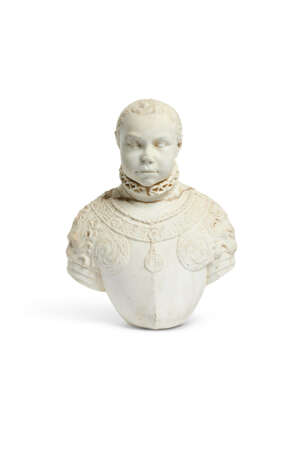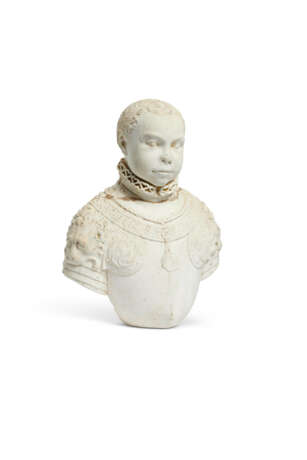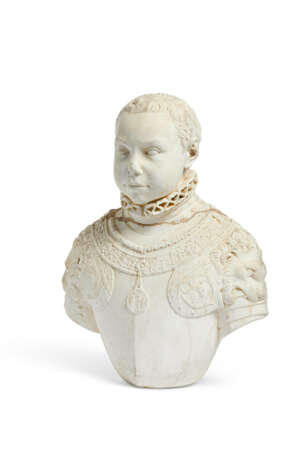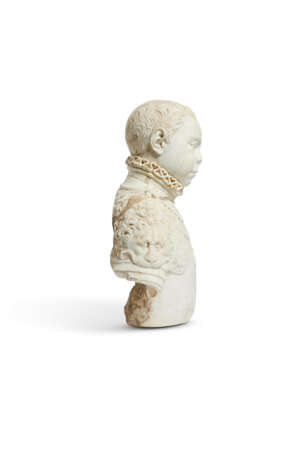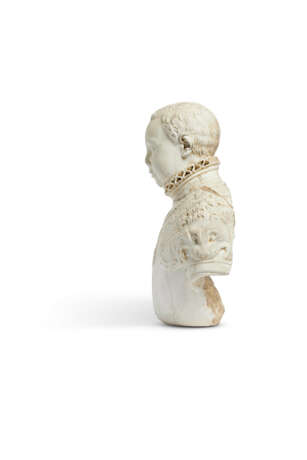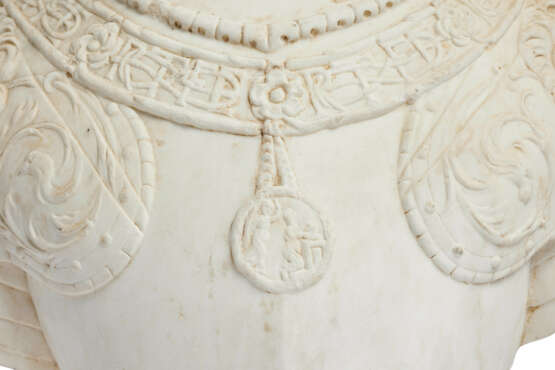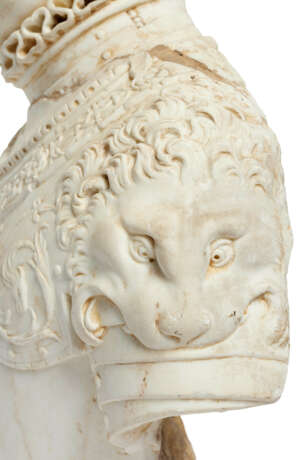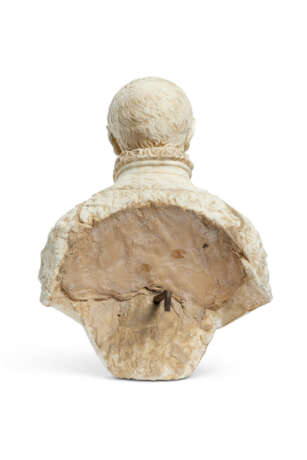ID 1164362
Lot 149 | BUSTE REPRÉSENTANT CARLO EMANUELE 1er DE SAVOIE (1562-1630)
Estimate value
€ 20 000 – 30 000
ATELIER DE LEONE LEONI,VERS 1570
En marbre ; manques et restaurations
H.: 50 cm. (19 2⁄3 in.) ; L.: 37,5 cm. (14 ½ in.)
Provenance
Collection Victor-Emmanuel, prince de Naples et duc de Savoie.
Literature
Bibliographie comparative :
E. Plon, Les maîtres italiens au service de la Maison d’Autriche. Leone Leoni, sculpteur de Charles Quint et Pompeo Leoni, sculpteur de Philippe II, Paris, 1887.
L. Mallé, Le sculture del museo d’arte antica. Museo Civico di Torino, Turin, 1965, p. 208, pl. 229.
U. Middeldorf, “On some portraits busts attributed to Leone Leoni”, in The Burlington Magazine, Février 1975, vol. 117, no. 863, pp. 84-89 et 91, fig. 18.
Los Leoni (1509-1608). Escultores del Renacimiento Italiano al servicio de la corte de España, cat. expo. musée du Prado, Madrid, 1994.
Further details
A MARBLE BUST REPRESENTING CARLO EMANUELE I OF SAVOY (1562-1630), WORKSHOP OF LEONE LEONI, CIRCA 1570
Born in 1509 in Arezzo, Leone Leoni likely began his training as a goldsmith. His early propensity for delicate metalwork, expressive portraiture and narrative storytelling quickly saw him rise to one of the foremost medallists working in Italy. By the 1540s his reach had expanded beyond the Italian States and the artist, alongside his son and collaborator Pompeo Leoni, travelled to Spain and the Netherlands under the patronage of the most powerful leaders of the Cinquecento; Charles V Holy Roman Emperor and Phillip II of Spain. Their success led to larger commissions and Leoni transferred his talents from miniatures to large bronze and marble works, including his most famous piece Charles V and the Fury 1551-5 (Prado Museum, in. no. E000273). During Leoni’s time at the court of Charles V, during which the emperor installed the artist in a flat below his royal apartments in order that he be able to observe the sculptor at work, he continued to receive countless commissions from royalty throughout Western Europe, his international reach expanding out to Austria, Germany and France.
The modelling of the present marble bust is very much within the spirit of Leoni family oeuvre and the handling of the ruched collar and the delicate execution of the features recalls the Bust of King Phillip of Spain (Metropolitan Museum of Art, New York, inv. 26.260.91), completed in the latter half of Leone and his son’s careers, Pompeo. Indeed, the bust of the young boy exhibits the skill of the workshop: the sensitivity and lightness of touch afforded to the handling of the juvenile features contrasts against the gravitas of the stature of the body, visually affirming the status and bright future of the young sitter. Dressed in military garb, his armour sports lion motifs on the shoulder plates and a chivalric chain is draped around his neck. The repeated motto of ‘FERT’ modelled into the chain itself and the pendulum depicting the annunciation identifies the chivalric order as that of The Supreme Order of the Most Holy Annunciation. First established in 1362, the Order was led by the Dukes of Savoy who took on the position of Grand Master. In 1570, Emmanual Philbert I took up the post, updating the statues of the regulations to enact his new vision for the established organisation. At the time, the present Duke’s son, Charles Emmanuel, was 8 years of age. Indeed, it is very possible that the young heir is the present sitter, the work likely commissioned in commemoration of Emmanual Philbert’s official foray into his position as Grand Master; the image of his son adorned with the chivalric chain a visual confirmation of the secured legacy of the Supreme Order. A beautifully bronze bust of the young Charles Emmanuel housed at the Philadelphia Museum of Art (inv. 1930-1-22) further supports this identification, the two statues mirroring one-another in the depiction of a youth with arched brows, tightly curled hair and military dress; as does a near identical marble bust in the Museum of Antique Art in Turin (see L. Malle, Le sculture del museo d’arte antica, Turin, 1965, p. 208, pl. 229). Attributed to Leone Leoni and identified as Carlo Emanuele of Savoy, the Turin example carries the same technical finesse as the present bust, however, there are a few differences: the armour without the lion masked shoulder plates with foliate scrolls and the pupils gazing upwards rather than directly forward. It is these small assertive details that distinguish the present bust as a powerful presentation of the young Charles Emmanuel.
| Medium: | Marble, Stone |
|---|---|
| Place of origin: | Italy, Europe |
| Auction house category: | All other types of objects, Sculptures, Statues & Figures, Statuettes |
| Medium: | Marble, Stone |
|---|---|
| Place of origin: | Italy, Europe |
| Auction house category: | All other types of objects, Sculptures, Statues & Figures, Statuettes |
| Address of auction |
CHRISTIE'S 9 Avenue Matignon 75008 Paris France | ||||||||||||||
|---|---|---|---|---|---|---|---|---|---|---|---|---|---|---|---|
| Preview |
| ||||||||||||||
| Phone | +33 (0)1 40 76 85 85 | ||||||||||||||
| Fax | +33 (0)1 40 76 85 86 | ||||||||||||||
| Conditions of purchase | Conditions of purchase | ||||||||||||||
| Shipping |
Postal service Courier service pickup by yourself | ||||||||||||||
| Payment methods |
Wire Transfer | ||||||||||||||
| Business hours | Business hours
|
